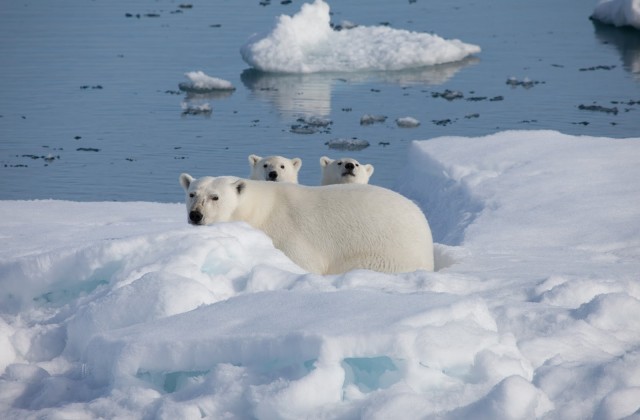Like polar bears? Pay a visit To The Arctic

IMAX’s ‘To The Arctic’ offers some stunning footage of a vanishing environment, but its child-geared narration and music could test the patience of adult viewers.
Nature documentaries are a hit and miss thing. Some of them can have a great story to build some amazing visuals upon, and some can simply have stunning visuals with no real substance behind them. Granted, it has to be difficult for a filmmaker to come up with an outline for a production and then have it all go out the door when it comes to filming. It’s not like the animals being filmed can read the script or take direction. The director is basically at the mercy of the elements, and can only hope that they have something, anything, to create a gripping story around the footage that has been shot.
And such is the case with the latest IMAX nature film, To The Arctic, a film which sets out to chronicle the plight of the Arctic polar bears (and other Arctic denizens) as their ice-covered habitat melts away. The 40-minute film follows a mama polar bear and her two cubs as they search for food and avoid a hungry male polar bear among the dwindling Arctic ice. As the region becomes warmer, the bears are running out of places to live and evade predators while their natural food source, sea lions, are becoming more scarce. The film alternately thrills the viewer as we get to watch the playful cubs romp around while the mother goes on the hunt for food, and makes us anxious as she stands her guard against a predator even while trying to catch a few winks.
The film also shows us how the walruses and caribou of the region are trying to adapt to the climate change (summer comes a month early now, creating havoc with the birthing season), and presents the effects of climate change on the region as large glaciers melt at alarming rates. But while the footage, both above the ice and underwater, is stunning there is a problem with the film as a whole … there’s just something about it that doesn’t totally enthrall you, even at a short 40 minutes. The biggest problem is narrator Meryl Streep, whose voice over is a bit too much in lullaby mode, using an almost breathy whisper that relaxes you even when the bears are in danger, and there are large portions of the film that don’t even have narration, using music by Paul McCartney to fill in the gaps.
And therein lies the film’s other problem: Paul McCartney’s music. Yes, McCartney is a genius but the music for this film is so cloying, so saccharine sweet that it makes your teeth hurt. It’s music more well suited to a baby’s nursery than a nature documentary. It really was that annoying.
The film’s home video presentation, now on Blu-ray/Blu-ray 3D and DVD, looks spectacular. For a film that’s color palette is mostly white, the image never looks blown out as whites can do, even under the bright sunlight. The blue water, the browns of the rocks and the greens of the inner terrain all look very natural. Regardless of any of the film’s storytelling flaws, you can always count on an IMAX film to at least look beautiful. For those of you with 3D TVs, the Blu-ray 3D image also looks stunning with some nice depth given to the locations and some nice shots of bears and walruses swimming underwater that almost put them in your face. The audio keeps the narration front and center with the music and various sound effects filling up the surround speakers (and if you’re just using your TV speakers, the music never over powers the narration).
The Blu-ray +DVD combo pack includes the film in 1080p HD on Blu-ray in both 2D and 3D versions with DTS-HD Master Audio English 5.1, and Dolby Digital 5.1 in French and Spanish. English, French and Spanish subtitles are also an option. An Ultraviolet version of the film is also included. Extras on the Blu-ray include a series of short behind the scenes featurettes all in HD:
- Pristine (2:00) — A brief look at the stunning Arctic locations which have never been filmed for an IMAX film before
- Life Under Water (3:24) — The crew talks about the dangers of filming in freezing water, and the possibility of being bait for the bears, as well as the rewards of shooting wildlife films. (Blu-ray only)
- The Challenges of Filming in the Arctic (3:15) — Crew members talk about the challenges and joys of shooting a film in such a harsh location. (Blu-ray only)
- To the Arctic with Meryl Streep (2:22) — Streep talks about her admiration for the filmmakers and her excitement about the IMAX format. (Blu-ray only)
- A Polar Bear Family (3:10) — The crew discuss filming the Polar bear mother and cubs.
- Welcome to the Arctic (3:06) — A wildlife photographer goes through the process of trying to get the right shot.
- Theatrical trailer (2:00; Blu-ray only)
What the extras highlight about the film is that there seemingly was not a plan, or at least a very different plan, in place when filming was scheduled. They seemed to have just lucked into capturing the footage of the mother and her cubs and decided to make them the subject of the film while still including the message about how climate change is affecting the region (which explains why we leave the bears to have a look at walruses and caribou along the way). This shift in the original plan hampers the film, which probably should have stuck to its intended subject, leaving the bears as peripheral characters instead of the leads. But they’re so adorable that you really can’t fault the filmmakers for placing them front and center.
 CliqueClack
CliqueClack


